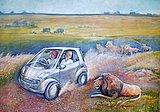Farmer Henry Schmedt
Foarma Hein Schmedt
 Foarma Hein Schmedt haft twee Kjinja. Daut Ellste es de Mejal,
dee heet Marieche, un es achtieen Joah oolt. Daut Tweede es de junge
Doft un dee es grod fief Joah oolt. Nu fählt Schmedt grod toofalig noch
een Peat, un eenes Doages well he noh Staudt foahre, eent opp'em
Peadmoakjt to kjeepe. He nemmt sien Doft met daut dee uk waut vom
Peadhaundel leahre kaun.
Foarma Hein Schmedt haft twee Kjinja. Daut Ellste es de Mejal,
dee heet Marieche, un es achtieen Joah oolt. Daut Tweede es de junge
Doft un dee es grod fief Joah oolt. Nu fählt Schmedt grod toofalig noch
een Peat, un eenes Doages well he noh Staudt foahre, eent opp'em
Peadmoakjt to kjeepe. He nemmt sien Doft met daut dee uk waut vom
Peadhaundel leahre kaun.Opp'em Moakjt bekjikt Schmedt sikj doa een schmocket Peat. He bekloppat daut von aule Siede, kjikt daut en'e Frät un besitt sikj de Tähne, häwt jieda Been aun un bekjikt sikj de Feet von unje un von bowe, bestrichelt de Been un de Schullre un häwt däm Zoagel un bekjikt sikj waut doarunja liggt. He nemmt siene goode Tiet doatoo, oba aum Enj woat he sikj eenig, un kjaft daut Peat. He bingt daut niee Peat hinjer'em Woage aun un dan foahre se auf noh Huus. Opp'em Huuswaig kome se em Vetahle äwa däm Haundel un dan well de Jung weete wuarom de Voda daut Peat soo väl bekloppat un bekjikt haud ea he
daut jekofft haud. "Na," saigt Schmedt to sien Jung, "wan ekj mi een Peat kjeepe well, dan mott ekj daut doch dichtig bekjikje un befeehle von unje bat bowe, daut ekj kraikt weet auf aules en Ordnung es un auf et uk jesund es, ea ekj doafäa Jeld utlaije doo. Daut vesteihst doch uk, nich, Doft?"
De Jung bleef lang stell, oba met'e Tiet kaum et bi ahm doch 'ruut, "Weetst uk waut, Pa? Ekj jleew ons Noba Peetasch sien Hauns well onse Marieche kjeepe!"
Farmer Henry Schmedt.
Farmer Henry Schmidt has two children. The oldest is a girl and she is called Maria, and is 18 years old. The second one is a boy Dave and he has just turned 5 years old. Now Schmidt as it happens, needs a horse, and one day he plans to travel to the city to buy one at the horse market.
He takes along his son Dave so that he can learn something about horse trading.
At the market Schmidt spies a beautiful horse and checks it out. He pats it from all sides, and looks into the horse’s mouth and examines the teeth, he lifts each leg and examines the feet both from underneath and from the top, He strokes the legs and the shoulders and even lifts up the tail to see what lays underneath.
He takes his own good time and finally comes to a decision and buys the horse. He ties the horse behind the wagon and then they travel home.
On the way home it came about that they began to talk about the transaction.
And then the boy wanted to know why his father had spent so much time patting the horse and looking at it before he bought it.
“Well,” said Schmidt to his son,
“when I want to buy myself a horse, then I must examine it carefully, and feel it with my hands from the bottom to the top,
so that I know exactly that everything is in order and if the horse is healthy, before I lay my money down for it.
The boy was silent for a long time, but after some time , he came out with “Do you know what Dad? I think that our neighbour Peter’s son Hans wants to buy our Maria!”



